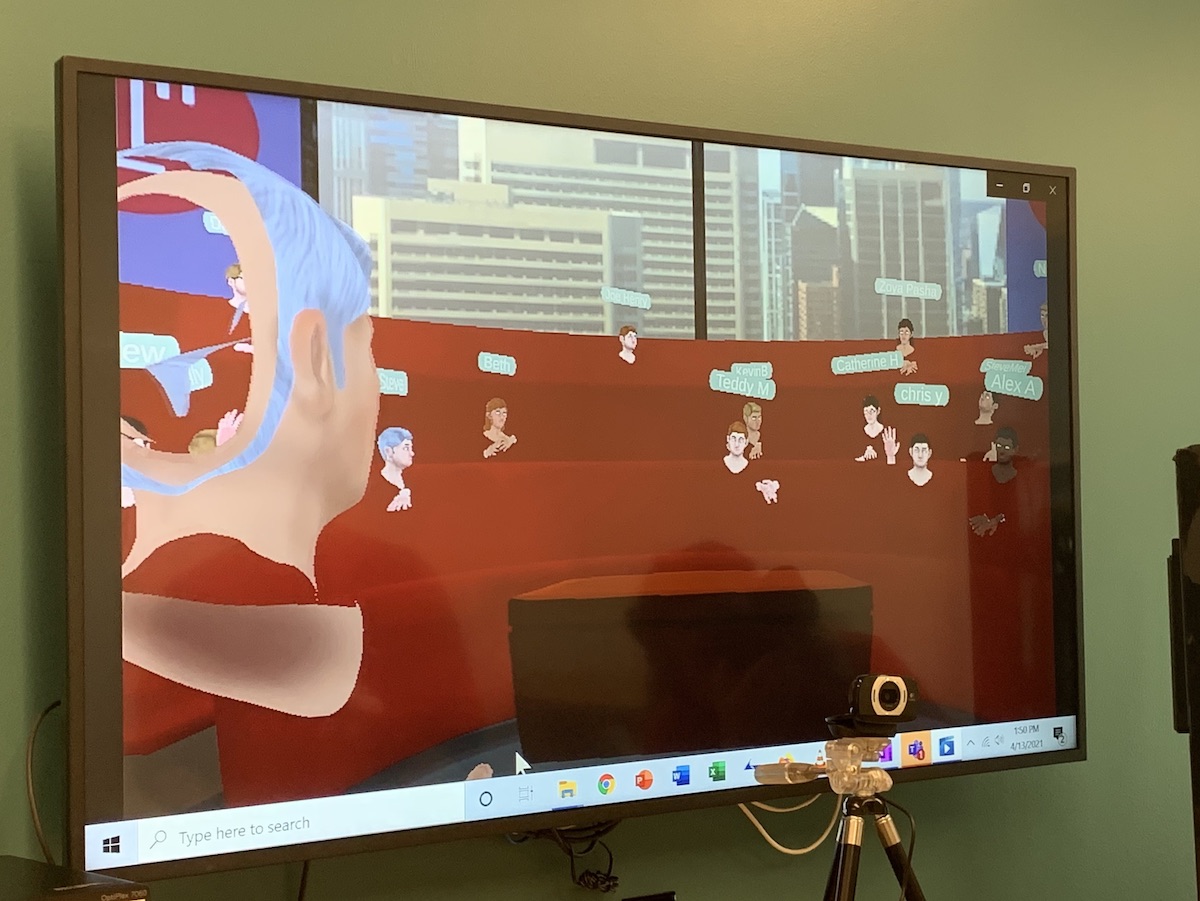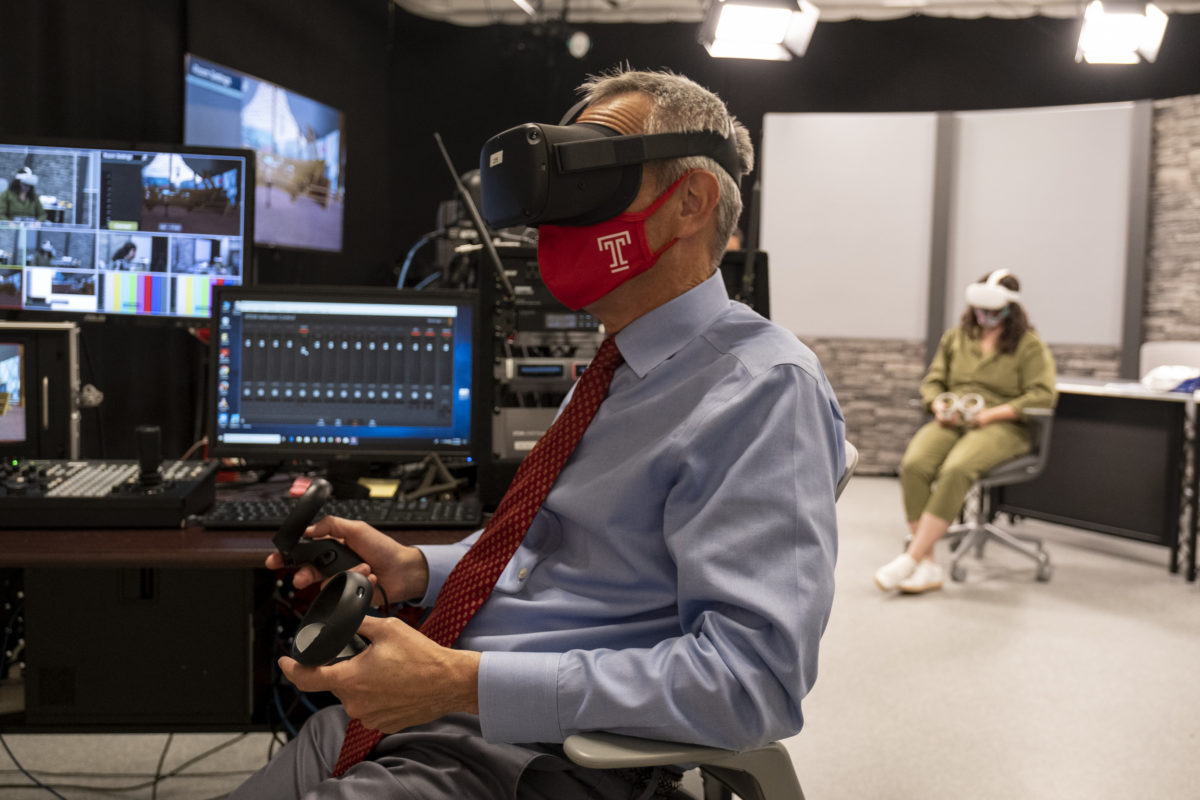The Tech Behind is a series in which we explore the technology that powers notable Philadelphia institutions. Have an idea for our next edition? Tell us.
On Tuesday, I found myself sitting in a lecture hall on Temple University’s main campus for the first time since my graduation in 2017.
The sun was shining through a set of large windows. I could see the Bell Tower in the distance and students mingled with each other as we waited for Bora Ozkan, Fox School of Business associate professor and director of the online MBA and online BBA programs, to join. Today, he was teaching “Fintech, Blockchain and Digital Disruption.”
But I wasn’t actually in a lecture hall. Neither were any of the people around me.
“I’m in South Philly,” one of the students nearby told me.
We were all attending class today from different parts of the city, or the world, in our own VR headsets. The classroom, a modern lookalike for any of the rooms in Anderson or Gladfelter Halls, was a simulation.
The class is one of the first of its kind in an MBA setting to use virtual reality to bring students together for discussion-based learning. The technology is often used to replicate hands-on trainings like for medical procedures or policing, but Gabby Gutierrez, a videographer for the online digital learning department at Fox, used her background in motion graphics to help build this setting to fit the classroom feel.
“Building this is like two different fields, you have the game designing aspect, the artistic, 3D-designing, and we were trying to figure out what works to bring into this environment,” she said.

Gabby Gutierrez (left) and Tom Lennon in a video studio. (Photo via Temple photographer Joseph V. Labolito)
Ultimately, Gutierrez used the 3D program Modo and game designing program Unity to build the classroom environment along with the Glimpse Group, a virtual reality and augmented reality platform company headquartered in New York City. They had to keep in mind that this environment was focused on communication and learning versus doing.
In the virtual world, students have some control over what they look like, Tom Lennon, a senior video production specialist in the Online and Digital Learning Department tells me. At the beginning of the seven-week course, students can fill out a survey about their basic looks. They still, however, appear as a bodiless avatars — a fact that was somewhat jarring at first until I realized that on Zoom, that’s pretty much all you get too.

A desktop version of the virtual classroom. (Photo via temple photographer Joseph V. Labolito)
Research and preparation for this course began before the pandemic made virtual learning a necessity. The team at Fox began prepping for a VR-taught course in 2019, and the first session kicked off for the spring 2020 semester. Now, in the pandemic’s virtual-fueled haze, it’s easy to see why students from different parts of the globe might want to feel like they’re sitting beside their classmates.
There’s also been some unintended benefits, Fox Dean Ron Anderson says. While you’re plugged in, there’s no way to be checking your email, looking at Instagram or even taking notes by hand. The platform allows the instructor to upload notes and materials for the class and students can control the presentation board in front of them, but you can’t aimlessly scroll the internet.
There are some caveats to the technology, like any other mediums. First, the Oculus VR headsets cost about $300 per set, and Temple currently is in possession of about 20 of them. They’re loaned out to the fintech students and eventually will need to be upgraded. And they’re subject to technical difficulties like any of the technology we lean on right now; I hopped into the class late because the headsets wouldn’t connect to Fox’s Wi-Fi for a bit.

Reporter Paige Gross in the virtual classroom. (Photo via Temple photographer Joseph V. Labolito)
But Anderson, Ozkan and others in the department say they see how VR will become more ubiquitous in learning experiences post-pandemic and beyond. There’s even a subset of students telling the school they prefer virtual learning overall.
“I don’t think there’s a majority, because there’s so much Zoom fatigue,” Anderson said Tuesday. “But give them a break, and come back rested and my expectation is 20 to 30% of students are going to want to be virtual.”
The setup works well for this fintech class, where the students spend much of the time talking, but it will likely be applied in other class types soon.
“The goal was to make that classroom truly immersive, so that the students are not just seeing the faculty and teaching team, and what Bora has to say, but seeing each other,” Lennon said. “And that was one of the first ‘wow’ moments we had when we got into the classroom. You’d hear someone talk and all of our heads would swivel around to look at them. It’s an experience so close to really being there.”
Before you go...
Please consider supporting Technical.ly to keep our independent journalism strong. Unlike most business-focused media outlets, we don’t have a paywall. Instead, we count on your personal and organizational support.
Join our growing Slack community
Join 5,000 tech professionals and entrepreneurs in our community Slack today!

The person charged in the UnitedHealthcare CEO shooting had a ton of tech connections

From rejection to innovation: How I built a tool to beat AI hiring algorithms at their own game

Where are the country’s most vibrant tech and startup communities?


